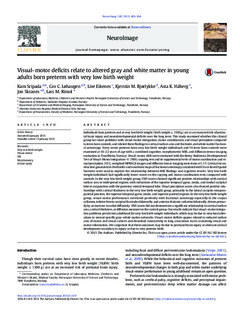| dc.contributor.author | Sripada, Kam | |
| dc.contributor.author | Løhaugen, Gro | |
| dc.contributor.author | Eikenes, Live | |
| dc.contributor.author | Bjørlykke, Kjerstin Myklebust | |
| dc.contributor.author | Håberg, Asta | |
| dc.contributor.author | Skranes, Jon Sverre | |
| dc.contributor.author | Rimol, Lars Morten | |
| dc.date.accessioned | 2018-09-13T14:08:27Z | |
| dc.date.available | 2018-09-13T14:08:27Z | |
| dc.date.created | 2015-06-15T12:30:27Z | |
| dc.date.issued | 2015 | |
| dc.identifier.citation | NeuroImage. 2015, 109 493-504. | nb_NO |
| dc.identifier.issn | 1053-8119 | |
| dc.identifier.uri | http://hdl.handle.net/11250/2562573 | |
| dc.description.abstract | Individuals born preterm and at very low birth weight (birth weight ≤ 1500 g) are at an increased risk of perinatal brain injury and neurodevelopmental deficits over the long term. This study examined whether this clinical group has more problems with visual–motor integration, motor coordination, and visual perception compared to term-born controls, and related these findings to cortical surface area and thickness and white matter fractional anisotropy. Forty-seven preterm-born very low birth weight individuals and 56 term-born controls were examined at 18–22 years of age with a combined cognitive, morphometric MRI, and diffusion tensor imaging evaluation in Trondheim, Norway. Visual–motor skills were evaluated with the Beery–Buktenica Developmental Test of Visual–Motor Integration—V (VMI) copying test and its supplemental tests of motor coordination and visual perception. 3D T1-weighted MPRAGE images and diffusion tensor imaging were done at 1.5 T. Cortical reconstruction generated in FreeSurfer and voxelwise maps of fractional anisotropy calculated with Tract-Based Spatial Statistics were used to explore the relationship between MRI findings and cognitive results. Very low birth weight individuals had significantly lower scores on the copying and motor coordination tests compared with controls. In the very low birth weight group, VMI scores showed significant positive relationships with cortical surface area in widespread regions, with reductions of the superior temporal gyrus, insula, and medial occipital lobe in conjunction with the posterior ventral temporal lobe. Visual perception scores also showed positive relationships with cortical thickness in the very low birth weight group, primarily in the lateral occipito-temporo-parietal junction, the superior temporal gyrus, insula, and superior parietal regions. In the very low birth weight group, visual–motor performance correlated positively with fractional anisotropy especially in the corpus callosum, inferior fronto-occipital fasciculus bilaterally, and anterior thalamic radiation bilaterally, driven primarily by an increase in radial diffusivity. VMI scores did not demonstrate a significant relationship to cortical surface area, cortical thickness, or diffusion measures in the control group. Our results indicate that visual–motor integration problems persist into adulthood for very low birth weight individuals, which may be due to structural alterations in several specific gray–white matter networks. Visual–motor deficits appear related to reduced surface area of motor and visual cortices and disturbed connectivity in long association tracts containing visual and motor information. We conjecture that these outcomes may be due to perinatal brain injury or aberrant cortical development secondary to injury or due to very preterm birth. | nb_NO |
| dc.language.iso | eng | nb_NO |
| dc.publisher | Elsevier | nb_NO |
| dc.rights | Attribution-NonCommercial-NoDerivatives 4.0 Internasjonal | * |
| dc.rights.uri | http://creativecommons.org/licenses/by-nc-nd/4.0/deed.no | * |
| dc.title | Visual-motor deficits relate to altered gray and white matter in young adults born preterm with very low birth weight | nb_NO |
| dc.type | Journal article | nb_NO |
| dc.type | Peer reviewed | nb_NO |
| dc.description.version | publishedVersion | nb_NO |
| dc.source.pagenumber | 493-504 | nb_NO |
| dc.source.volume | 109 | nb_NO |
| dc.source.journal | NeuroImage | nb_NO |
| dc.identifier.doi | 10.1016/j.neuroimage.2015.01.019 | |
| dc.identifier.cristin | 1248207 | |
| dc.description.localcode | © 2015 The Authors. Published by Elsevier Inc. This is an open access article under the CC BY-NC-ND license (http://creativecommons.org/licenses/by-nc-nd/4.0/). | nb_NO |
| cristin.unitcode | 194,65,15,0 | |
| cristin.unitcode | 194,65,25,0 | |
| cristin.unitcode | 194,65,30,0 | |
| cristin.unitname | Institutt for klinisk og molekylær medisin | |
| cristin.unitname | Institutt for sirkulasjon og bildediagnostikk | |
| cristin.unitname | Institutt for nevromedisin og bevegelsesvitenskap | |
| cristin.ispublished | true | |
| cristin.fulltext | original | |
| cristin.qualitycode | 2 | |

